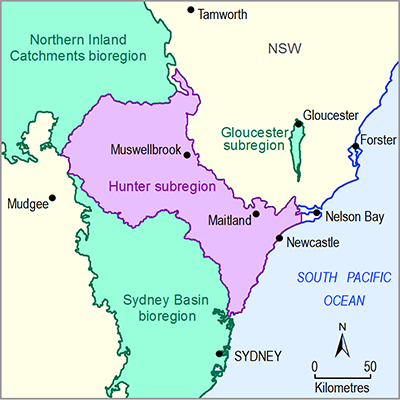As described previously (Section 1.1.3.1), the Sydney Basin is part of the Sydney-Gunnedah-Bowen Basin (SGBB) complex. The dominant tectonic feature of eastern Australia, the Tasman Fold Belt, is composed of five fold belts of which three are either wholly or partly in NSW: the Kanmantoo, Lachlan and New England fold belts (Scheibner, 1999, p. 18). Of these, the Lachlan Fold Belt and the New England Fold Belt are separated by the SGBB (Figure 28).
The Sydney-Gunnedah Basin is bound by older Paleozoic, mainly metamorphic and granitic rocks of the Lachlan Fold Belt, to the south and west, and the New England Fold Belt to the north-east. A series of tectonic events led to the formation of the basin complex and the comprehensive reconstruction of its tectonic development in NSW is discussed by various authors including Johnson (1989), Scheibner (1999), Veevers (2000) and Woodfull et al. (2004).
The structure of the SGBB complex was influenced primarily by events during the Middle Devonian to early Carboniferous, which gave rise to the Kanmantoo and Lachlan fold belts. By the end of the Kanimblan Orogeny (early Carboniferous) the fold belts had emerged as new cratons. Post-orogenic magmatism related to a subduction-associated volcanic arc (where deep, lithospheric material subducts and recycles large amounts of oceanic crust) was present in the New England Fold Belt region. Plate interaction ended in the New England region during the late Carboniferous and the rocks were subjected to strong contraction. During the contraction the fore-arc basin complexes were thrust over the volcanic arc. This orogenic pile-up of the early New England Fold Belt over the edge of the Lachlan Fold Belt caused foreland loading and lithospheric flexure, and the down-bowed area became the future depositional site for the SGBB (Scheibner, 1999, p. 26).
During the late Carboniferous to early Permian, a continental rift formed in the down-bowed region, which later developed into a transitional tectonic foreland basin, the SGBB. During the middle Permian, orogenic contraction and further rise of the New England region during the Hunter Orogeny caused renewed foreland loading of the down-bowed region. Coal measure sedimentation began in the early Permian with detritus supplied from the eastern orogenic belt. Compressional movements were accommodated by the Hunter-Mooki Thrust Fault System (Tadros, 1995, p. 166).
Compression intensified towards the end of the Permian, causing major uplift and basin tilting, and coal measure sedimentation was terminated. The New England Fold Belt experienced widespread post-orogenic magmatic activity from the middle Permian to the early Triassic. Tectonism during the Middle Triassic Bowen Orogeny was mainly confined to folding and thrusting, which deformed the rocks of the SGBB and the New England Fold Belt (Scheibner, 1999, p. 27).
Deposition of sediments and coal measures in these basins continued into the early Cretaceous. During this time, mantle upwelling started under the continent that was, at the time, part of Gondwana, with related intraplate igneous activity. The Australian continent rifted and broke away from the rest of Gondwana. The rifting progressed anticlockwise southwards during the early Cretaceous between Australia and India, and later eastwards between Australia and Antarctica (Scheibner, 1999, p. 28). The continent underwent further rifting during the Jurassic and a marine incursion occurred during the early Cretaceous. The Eastern Highlands became elevated during the late Cretaceous and this continued into the Cenozoic as a result of intraplate igneous activity (Scheibner, 1999, p. 28).
The Sydney Basin sequence was affected by three major phases of igneous activity dating from the late Palaeozoic to the middle to late Cenozoic (Thomas and Hill, 2003, p. 1). Volcanic activity commenced in the New England Fold Belt during the middle Permian to Triassic, peaking during the late Permian, which is consistent with the range of dates (247.7 to 271.4 Ma) for tuff layers associated with the Permian coals of the Hunter Coalfield (Metcalfe et al., 2012, p. 1). Along with volcanic and volcaniclastic rocks commonly being interlayered with the sedimentary strata, this indicates that volcanic activity occurred in the period contemporaneous with sedimentation, with volcanism contributing large quantities of volcanogenic material to the sedimentary sequence.
A second period of igneous activity was related to mantle upwelling at the beginning of the breakup of Gondwana during the Jurassic and Cretaceous (Scheibner, 1999, p. 29), and the possibility of late intraplate volcanism during the last approximately 10 Ma has also been investigated by Sutherland (1992). A comprehensive review of the Cenozoic volcanism in Australia was conducted by Vasconcelos et al. (2008), which confirmed these findings.

